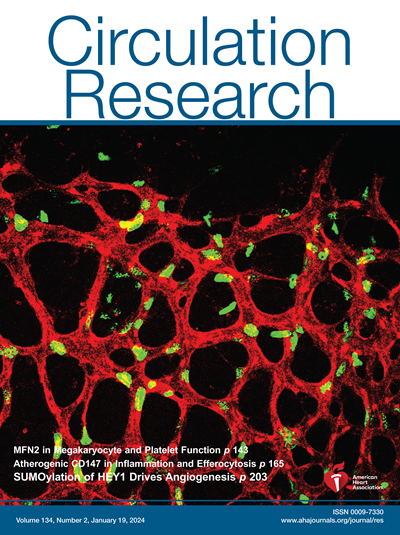星形神经节:心脏病恶性室性心律失常的关键治疗靶点。
IF 16.5
1区 医学
Q1 CARDIAC & CARDIOVASCULAR SYSTEMS
引用次数: 0
摘要
恶性室性心律失常(VAs),如室性心动过速和心室颤动,是美国每年约50万人死亡的原因,这是心脏病常见的致命事件,如高血压、儿茶酚胺能多形性室性心动过速、takotsubo心肌病、长qt综合征和进展为晚期心力衰竭。这些心脏疾病的一个共同特征,以及VAs的后续发展,是交感神经系统的过度激活。目前这些心脏疾病的VAs治疗,如β-肾上腺素受体阻滞剂和心脏交感神经消融术,旨在抑制心脏交感神经过度激活。然而,这些治疗方法并不能转化为有效的室性心动过速/室颤事件的长期抑制剂。作为心脏的关键调节成分,位于星状神经节(SGs)的心脏节后交感神经元释放神经递质(如去甲肾上腺素和NPY[神经肽Y]),在心脏功能中发挥调节作用。动物实验和临床研究越来越多的证据表明,SG的重塑可能与恶性心律失常的发生密切相关。这表明SG是治疗心脏病中恶性VAs的关键潜在治疗靶点。因此,本文综述了SG在室性心律失常发生中的作用,并对SG在心脏病VAs临床治疗中的新靶点进行了更新。本文章由计算机程序翻译,如有差异,请以英文原文为准。
Stellate Ganglia: A Key Therapeutic Target for Malignant Ventricular Arrhythmia in Heart Disease.
Malignant ventricular arrhythmias (VAs), such as ventricular tachycardia and ventricular fibrillation, are the cause of approximately half a million deaths per year in the United States, which is a common lethal event in heart disease, such as hypertension, catecholaminergic polymorphic ventricular tachycardia, takotsubo cardiomyopathy, long-QT syndrome, and progressing into advanced heart failure. A common characteristic of these heart diseases, and the subsequent development of VAs, is the overactivation of the sympathetic nervous system. Current treatments for VAs in these heart diseases, such as β-adrenergic receptor blockers and cardiac sympathetic ablation, aim at inhibiting cardiac sympathetic overactivation. However, these treatments do not translate into becoming efficacious as long-term suppressors of ventricular tachycardia/ventricular fibrillation events. As a key regulatory component in the heart, cardiac postganglionic sympathetic neurons residing in the stellate ganglia (SGs) release neurotransmitters (such as norepinephrine and NPY [neuropeptide Y]) to perform their regulatory role in dictating cardiac function. Growing evidence from animal experiments and clinical studies has demonstrated that the remodeling of the SG may be intimately involved in malignant arrhythmogenesis. This identifies the SG as a key potential therapeutic target for the treatment of malignant VAs in heart disease. Therefore, this review summarizes the role of SG in ventricular arrhythmogenesis and updates the novel targeting of SG for clinical treatment of VAs in heart disease.
求助全文
通过发布文献求助,成功后即可免费获取论文全文。
去求助
来源期刊

Circulation research
医学-外周血管病
CiteScore
29.60
自引率
2.00%
发文量
535
审稿时长
3-6 weeks
期刊介绍:
Circulation Research is a peer-reviewed journal that serves as a forum for the highest quality research in basic cardiovascular biology. The journal publishes studies that utilize state-of-the-art approaches to investigate mechanisms of human disease, as well as translational and clinical research that provide fundamental insights into the basis of disease and the mechanism of therapies.
Circulation Research has a broad audience that includes clinical and academic cardiologists, basic cardiovascular scientists, physiologists, cellular and molecular biologists, and cardiovascular pharmacologists. The journal aims to advance the understanding of cardiovascular biology and disease by disseminating cutting-edge research to these diverse communities.
In terms of indexing, Circulation Research is included in several prominent scientific databases, including BIOSIS, CAB Abstracts, Chemical Abstracts, Current Contents, EMBASE, and MEDLINE. This ensures that the journal's articles are easily discoverable and accessible to researchers in the field.
Overall, Circulation Research is a reputable publication that attracts high-quality research and provides a platform for the dissemination of important findings in basic cardiovascular biology and its translational and clinical applications.
 求助内容:
求助内容: 应助结果提醒方式:
应助结果提醒方式:


